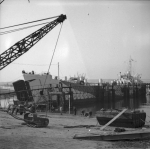NavSource Online: Amphibious Photo Archive
HM LST-364

LST-364 was transferred to the United Kingdom for the duration of World War II
Please report any broken links or trouble you might come across to the Webmaster. Please take a moment to let us know so that we can correct any problems and make your visit as enjoyable and as informative as possible.

Royal Navy History Commissioned into the Royal Navy as HM LST-363, 7 December 1942 Sailed from New York, 19 March 1943 as straggler to convoy UGS-6A During World War II HM LST-364 was assigned to the European Theater and participated in the following campaigns:
- Sicilian occupation, 9 and 10 July 1943
- Salerno landings, September 1943
- West Coast of Italy operations - 1944 - Anzio-Nettuno advanced landing, 22 January 1944
- Invasion of Normandy, June 1944
Operated in the shuttle service between Tilbury, Ostend and Antwerp Sunk while in convoy TAM-87 by a German Uboat (Seehund) 2-man midget submarine off Margate, 22 February 1945
| Click On Image For Full Size Image |
Size | Image Description | Source | |
|---|---|---|---|---|
 |
97k | HM LST-364 beached on a "Hard" that is under construction, location unknown. Photo taken by Bert Hardy, War Office official photographer. Photo No. H 38512 from the collections of the Imperial War Museums. Part of the War Office Second World War Official Collection. | Robert Hurst | |
 |
43k | HM LST-364 and HM LST-162 and a number of unidentified landing craft beached while unloading during a rehearsal for the Normandy landings, date and place unknown. | Ed Storey | |
| Back To The Navsource Photo Archives Main Page | Back To The Amphibious Ship Type Index | Back To The Tank Landing Ship (LST) Photo Index |
| Comments, Suggestions, E-mail Webmaster. |
|
This page created and maintained by Gary P. Priolo |